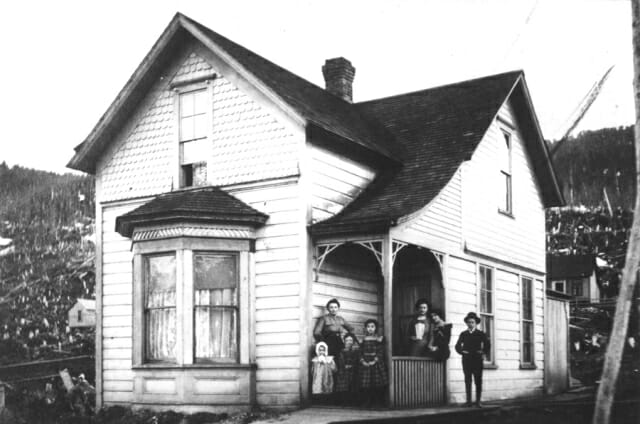Gastineau Channel Memories
Museth/Williams
Don Williams
Hendrik and Marta Mjaaset and infant child, Anna, emigrated from Voss, Norway, to America in 1881, settling in Michigan. In 1893, Hendrik and some friends went to Alaska to search for better jobs. They found good opportunity at Treadwell Mines in Douglas, Alaska. In 1894, Marta and the children joined a small group of other families (mostly Scandinavian) who traveled together to rejoin their husbands in Douglas. Hendrik had worked many extra shifts at the mine and had bought a house ready for the family when they arrived.
The two youngest daughters, Nora and Trine, were born in Douglas in the family home in 1895 and 1897, respectively. By this time, the family included five daughters and one son. Hendrik and Marta?s names were Americanized to Henry and Martha Museth. The Museth family enjoyed living and working in Douglas and Treadwell. Henry originally started working as a miner at Treadwell in 1893; when he retired in 1923, he was chief amalgamator in the mill. During this time, Henry studied to take the citizenship test, passed it and became a U.S. citizen.
Nora Museth Williams lived either in Douglas or in Juneau until 1957, and remembered the Treadwell Mines being very generous in helping the community in many projects. They built a big building called the Natatorium, as it had a swimming pool in the basement while the upstairs had a stage, hardwood dance floor, and a gymnasium, and the building also served as a roller skating rink. The company also provided a lovely theater for Douglas as well as a fine band with a bandmaster from the states. The band played for all celebrations and also for the funerals. About 1912 or 1913, the Treadwell company built a large building and called it the Treadwell Clubhouse. The new facility housed a stage, dance floor, bowling alleys, library, pool tables, a barbershop, and a store that sold candy, magazines, tobacco, etc. The pool in the adjacent Natatorium was beautifully tiled and the water was heated. The water was freshwater some days and salt water others. The pool building also contained bathtubs so people without indoor plumbing could have hot baths. There was an attendant who handed out towels and soap. All the facilities were available to employees and their families for a 50-cent per month fee, which was deducted from their pay. There were weekly dances at the Clubhouse with a seven piece orchestra.
The Friends Church played a big part in the lives of the kids and most families in Douglas. The church was a big organization run by Missionaries from the states aimed mostly at working with the Indians, but they were wonderful people and dedicated to helping anyone they could. On nights when the church held services for the Indians, the Indians would form a procession and march from their homes along the beach about three-fourths of a mile to the church. They carried lighted torches and lanterns as there were no street lights.
The Taku wind blows terribly strong in Douglas every winter. Nora remembered walking with her sister, Agnes, in Douglas one day when the Taku was blowing especially hard. A strong blast of wind picked up a street plank (the streets were wooden planks), a 2\" by 12\" about 10 feet long; and it hit her squarely on the behind.
When Nora was in high school, she got a job as a projectionist at the local theater. Moving pictures were quite new, and the films came from Seattle on several reels. Her job was to thread the film through the projector and then turn the reels with a hand crank at a steady rate to make the pictures move. The light for the projector came from an arc between two carbon electrodes, which had to be trimmed and spaced properly to keep a bright, steady light. If the reel was stopped, the arc would burn the film in two, and she would have to splice it together before starting again. After graduating from high school in 1914, she got a job in the post office with a salary of $45 per month. When her dad first began working at the Treadwell Mine, wages were about $2 for a twelve hour day. The Treadwell Post Office was located in the company building where the miners were paid once a month. When business happened to be slack on a payday, she would help out by putting the miner?s pay in each man?s envelope. They were paid in cash - gold and silver coins. The gold coins came in denominations of 20, 10 and 5 dollar pieces and were always clean and nice to handle.
Agnes graduated from Douglas High School in 1910, and Nora graduated in 1914. Nora was the only senior in Douglas that year, so for the last half of the year, she joined four seniors at Juneau High School. Agnes attended a one-year business college in Tacoma before she began her working career as a stenographer in the Treadwell Company office. In 1911, John Museth married Verna Margaret Bean, a young lady from Juneau. From 1917 to 1919, John served in the U. S. Army. When the war ended, he began work for the Pacific Coast Steamship Company and later the Alaska Steamship Company. Ann Marie began working at the Juneau Post Office and continued to live at home and commuted to and from work each day on the Juneau Douglas ferry. In 1910, she married John H. Davies, a young man who was the purser on a small steam vessel which carried mail and passengers among the towns and villages. Ann and Jack then moved to Ketchikan where Jack later became a deputy U.S. Marshall, and they raised their two boys, Jack M. and Thomas B. In 1913, he was elected to Alaska?s first legislature, when Alaska became a territory. He later started an insurance business in Ketchikan, which is still operating and is being run by his grandsons. During World War II, Jack M. Davies served as a Coast Guard officer in Alaskan waters. In 1906, Min married Jack Stoft, a young man originally from Omaha, Nebraska, who came to Treadwell to work. Jack and Min later moved to Petersburg, Alaska, where they raised their family of three children - Wesley, Dorothy, and Robert.
In 1923, Henry became quite ill and retired after thirty years working at Treadwell. The family home was sold along with all the family furniture for $450. Henry, Martha, Agnes, Nora and Trine boarded the steamer, Queen for the first leg of their trip to Escondido, California. Henry enjoyed three years of retirement anddied in 1926, at the age of 72. Martha, Agnes and Trine remained in Escondido. Nora returned to Alaska as the bride of Joe Williams, a young man who worked as an engineer for Treadwell. He and Nora were engaged before Nora left Alaska. They were married on April 21, 1925, and shortly returned to Alaska.
Joe Williams was born in Canada. His father was John O?Brien Williams, a Yukon riverboat pilot and captain. His mother was Josephine Eholt Williams who emigrated from Alsace to Canada in about 1886. The family lived in Whitehorse, Yukon Territory. Joe attended Canadian schools including the University of British Columbia. However, he attended his last year of college at the University of Washington, where he earned a degree in mining engineering. Joe later served in the Canadian Army in World War I. In 1920, after the war, Joe came to Treadwell to work as Chief Assayer. When Joe and Nora returned to Alaska after their marriage, they made their new home in Juneau, where Joe had just started to work for Alaska Juneau Gold Mining Company. They loved Juneau and socializing with friends from both Juneau and Douglas. They raised a family of four children - Irene Patricia, Donald Museth, John Rodney and Marjorie Josephine. Joe started at Alaska Juneau Gold Mining Company as a staff engineer. He later took a citizenship test and became a U. S. citizen. In 1940, upon the death of Louis Metzgar, Joe became superintendent of the company. He also served on the company?s board of directors and led the company in both prosperous and lean years. He also served on the board of directors of First National Bank of Alaska. In 1957, after 33 years at Alaska Juneau, Joe retired, and he and Nora moved to Escondido. The four Williams children grew up in Juneau and all graduated from Juneau High School. They have memories of good friends, school fun, fishing and hunting trips, summers at the cabin, first jobs, neighbors and life in a small town. In 1950, the Korean War started, and Don, Rod and many other young men from Alaska served a two-year military tour at Fort Richardson and other Alaska posts. In 1952, Don Williams married Patricia Anne Garrett of Juneau. The Williams children lived and worked at various jobs in Alaska until moving to western Washington to live and eventually raise their own families. In 1983, Joe and Nora moved to Seattle, ashington, at the age of 88, to be close to their children. Joe died at the age of 94, in 1989, and Nora died at the age of 98 in 1994. Their oldest child, Irene, died in 1993, at the age of 67.
The only descendents of the original Museth family still residing in Alaska are the descendents of Ann Marie and John H. Davies living in Ketchikan.
Following are the members of the original pioneer family:
Henry Museth 1854-October 1926
Martha Museth 1859-March 1948
Ann Marie Museth Davies 1880-October 1973
John H. Davies 1875-1935
Min Museth Stoft 1883-November 1964
Jack Stoft 1878-1942
Nikolai Museth 1885-1894
John L. Museth 1888-July 1951
Verna Bean Museth 1892-November 1982
Agnes Museth 1892-December 1977
Nora Alice Museth Williams 1895-January 1994
Joseph A. Williams 1895-May 1989
Trine Museth 1897-June 1988


